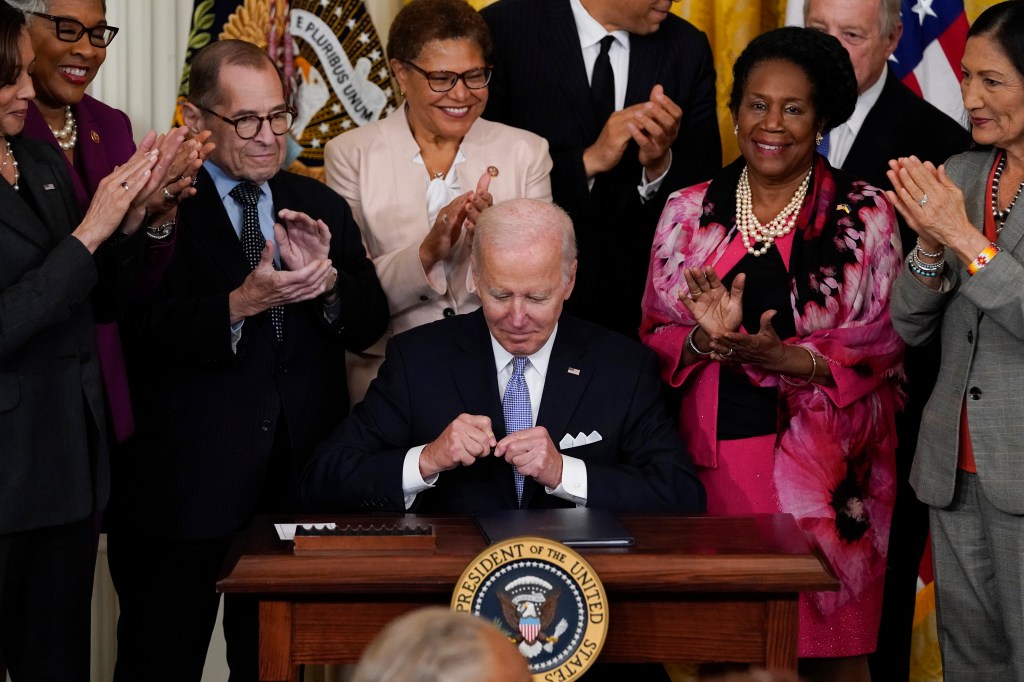Agencies react to Biden’s executive order on police reform
Published 5:54 pm Wednesday, June 8, 2022

- Biden Police OrderPresident Joe Biden signs an executive order in the East Room of the White House, May 25, 2022, in Washington. The order comes on the second anniversary of George Floyd’s death, and is focused on policing.
ATLANTA — Police reform has been a controversial topic in the wake of protests in Georgia and across the nation over the number of Black people killed by police.
On the two-year anniversary of George Floyd’s death, May 25, 2022, President Joe Biden signed an executive order that addresses only the surface of police reform, at least for federal agencies.
Trending
“Police cannot fulfill their role to keep communities safe without public trust and confidence in law enforcement and the criminal justice system,” a White House statement reads. “To heal as a nation, we must acknowledge that fatal encounters with law enforcement have disproportionately involved Black and Brown people.”
Several studies and data sources have shown that Black people are killed by police at a disproportionate rate; As it pertains specifically to shooting deaths, The Washington Post — which has logged fatal police shootings since 2015 — reports that Black Americans are killed by police at more than twice the rate of white Americans, though Black people only make up 13 percent of the country’s population.
Floyd, a Black man, died in Minneapolis while a white officer kneeled on his back for nearly 10 minutes, stating throughout that he couldn’t breathe. Other officers at the scene did not intervene and were federally charged in February for aiding and abetting by failing to intervene or provide medical aid.
“The other officers should have acted themselves and stopped it right there and if they had been my officers, they would have been fired immediately,” Lowndes County, Ga., Sheriff Ashley Paulk said.
Part of Biden’s order imposes a duty of federal officers, and recommends local officers, to intervene to stop excessive force and a duty to render medical aid.
Cullman County, Ala., Police Chief Kenny Culpepper said the provision is a commonsense reform.
Trending
“It was a very difficult situation for the other officers because they were brand new or rookies and you’ve got a sergeant that’s responsible,” said Culpepper, referencing the George Floyd incident. “But we’ve told our folks is that if you see, like me the chief, screwing up, then you step in and let me know. I understand, being a long-term law enforcement officer, how difficult it is for a new person to do that in any job.”
While the order, overall, issues mandates to federal law enforcement agencies, local law enforcement agencies are encouraged to adopt some of its federally mandated police reforms, although many agencies already have policies included in the order.
The order, in part, mandates federal agencies — and encourages state and local agencies, with assistance from federal grants, to:
- Adopt and publicly post body-worn camera policies that mandate activation of cameras during activities like arrests and searches
- Ban the use of chokeholds and carotid restraints unless deadly force is authorized and restricts the use of no-knock entries
- Authorize use of force only when no reasonably effective, safe, and feasible alternative appears to exist; authorizes deadly force only when necessary
- Implement screening tools to ensure that agencies do not hire or retain, or partner with on task forces, individuals who promote unlawful violence, white supremacy, or other bias on the basis of protected characteristics
- Develop an evidence-informed training module for law enforcement on implicit bias and avoiding improper profiling based on the actual or perceived race, ethnicity, national origin, limited English proficiency, religion, sex (including sexual orientation and gender identity), or disability of individuals
The FBI developed the National Use-of-Force Data Collection and began accepting data on Jan. 1, 2019, to collect data on use-of-force, including demographic information, throughout the country.
In 2021, only 44 percent of all law enforcement agencies participated in voluntary reporting of use-of-force incidents to the FBI.Among those, 33.5 percent of incidents resulted in death, and 50 percent resulted in bodily injury.
Alabama had a nearly 100 percent participation rate, while Georgia agencies had a 9 percent participation rate; Moultrie and Thomasville police departments were among the participants.
“It’s a valuable tool,” Culpepper said, adding his encouragement to all agencies to use the database.
Some research shows that use of body cameras reduces use of force incidents and the number of agencies moving toward the use of body cameras continues to increase.
Among agencies that had acquired body cameras as of 2016, 60 percent of local police departments and 49 percent of sheriffs’ offices had fully deployed them, according to Bureau of Justice Statistics.
“We require a deputy to have a film of any interaction he has, and if he doesn’t, he gets a week off and if he has a second incident within one year he’s fired if he can’t produce the film,” Paulk said of the agency’s body camera policy. The agency implemented its body cameras in 2017.
Culpepper agrees with the ban of chokeholds, stating that it is no longer taught at police academies in Alabama; Paulk said the same of his department in South Georgia.
“We’ve never used it unless absolutely it is your last resort. It’s already been in our written criteria for years,” Paulk said; Paulk now lauds use of bright yellow tasers as a primary use of restraint when use-of-force may be necessary.
“There’s been a case where supposedly the officer drew the wrong weapon. Ours are bright in color, and they’re where you have to draw your taser cross-handed, which you would not do with your weapon,” Paulk explained. “I strongly recommend (other agencies) use them. I mean, because in the heat of the moment you’re looking for your weapon but you certainly should be able to tell the difference, even by weight and everything else.”
Lt. Ronald Jordan of the Colquitt County Sheriff’s Office in Georgia said his staff are trained to use the arm bar restraint on combative or resistant detainees. The method involves grabbing the purported suspect’s wrist and applying pressure to their elbow to get them to the ground. He disagrees with banning chokeholds as an option for restraint.
“The only time we are to use chokeholds is if we have basically probable cause to believe that that is a deadly force situation or if it’s reasonable to use it,” Jordan said. “Basically, as an example, they had a knife or a gun and you are in a struggle with them. You’d be allowed to use a chokehold in this situation. Just to arbitrarily use those in any situation, though, it’s actually forbidden in our policy.”
Protests stemming from killing of 26-year-old Breonna Taylor by police in Louisville, Ky., paved the way for Biden’s provision to ban no-knock warrants. Officers erroneously burst into her home while performing a no-knock warrant as part of a drug investigation.
Culpepper said he was undecided on his support for restrictions on unannounced, no-knock warrants.
“Sometimes it may be warranted, depending on the degree of danger, like if a person is known to be armed and is known to be a threat to law enforcement.” he said. “There should be a best practices or absolutes, like ‘Absolutely you should not do this.’ … But every now and then there may be circumstances where it’s warranted.”
Jordan said no-knock warrants are rarely used but are beneficially in many cases.
“In my three to four years in investigations, I didn’t recall us doing a no-knock warrant, but it’s a good tool to have when needed. It’s used when there’s a very high probability or high chance that the person inside is going to be armed.”
This year, several police accountability related bills, similar to those included in the executive order, failed to advance in state legislatures.
In Alabama, a bill that would have a prohibited law enforcement officers from using the so-called four-point restraint, confining someone face-down on the ground by connecting and fastening an individual’s hands and legs together behind his or her back, as used on Floyd — stalled in the legislature.
“It depends on the individual and the circumstances and the degree of resistance,” Culpepper said. “If they’re completely out of control and they’re fighting you with all of their strength, sometimes that may be required until help can arrive. But as soon as you’re able to, or as soon as they stop resisting, you should for sure sit them up, stand them up, or put them in the car.”
In Georgia, a bill that would have required peace officers to successfully complete implicit bias training regarding race, gender, age, disability, religion, and sexual orientation stalled.
The Alabama Peace Officers’ Standards and Training Commission in August 2020 mandated that all certified law enforcement officers in the state of Alabama receive the 4-hour “Implicit Bias: Concepts and Countermeasures” course.
In Georgia, the Lowndes County Sheriff’s Office is among several Georgia agencies that participate in such annual training, Paulk said.
“You also have to pass a pretty strict psychological exam to be hired by us,” Paulk said as another means of gauging a potential officer’s bias. “It’s very strict; it’s reviewed by six other people.”
Mississippi had a proposal to create a review board for officer-involved deaths that would receive and review information from agencies in the state regarding officer involved deaths, and make recommendation to the attorney general; the board would have also been tasked with creating an annual report to be submitted to the Legislature by Dec. 31 of each year that includes the number of officer-involved shootings throughout the state, the race and ethnicity of the persons who are killed, and the name and the location of the law enforcement agency involved.
HB 969, or the Public Safety Through Hiring Act,” in Tennessee would have prevented law enforcement agencies from hiring a (former officer) who was fired, resigned or retired due to disciplinary infractions or while under investigation for misconduct in the line of duty.





